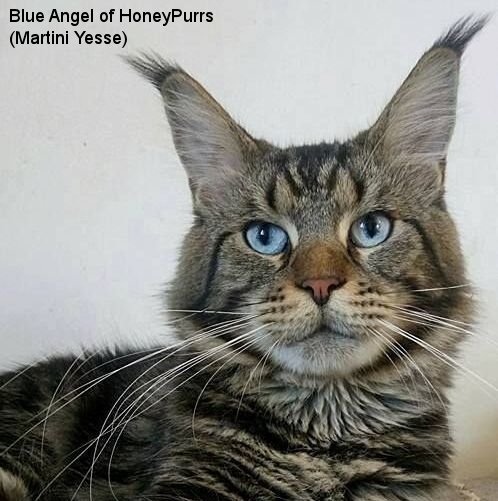
BLUE-EYED BREEDS - BLUE-EYED MAINE COON - Rociri Elvis Gene DBERE, Agostino Gene DBEAGO, Pillowtalk Ricardo Line & ALTAI MAINE COON (Roxi Darlin DBECEL) Genes
BLUE-EYED BREEDS - BLUE-EYED MAINE COON (Rociri Elvis Gene, DBERE)
Blue eyes are not uncommon in cats with a high degree of white on the face, but it is unusual to find blue eyes in a cat with little or no white. There is an odd-eyed non-white Maine Coon in Italy. There is even a breeding line of Maine Coons that have blue eyes but no white. There are some breeders in Russia, Italy, the Netherlands and Belgium.
Although the gene is referred to as the Rociri Elvis DBERE gene (and other lines have bred DBE Maine Coons from his descendants) and it was considered a spontaneous mutation in Elvis, DNA found it to be a latent gene (hiding in white cats) traceable to Justcoons Ha Shisch. The gene then skips a few generations, but can be traced back to JW Olmocabe's Alastor. The trail then goes cold and it can't be traced any further back.
In the Netherlands, Joyfield Faith is a Blue-Cream Silver and White Maine Coon with blue eyes. Her sire is Cream-and-white (non-silver) with blue eyes. Alice Gal - van Valkengoed provided information about the stunning blue-eye mutation in the Joyfield line. She and her husband bought cream-and-white Rociri's Elvis from Ciska Mennings, choosing him when he was only one day old. They were on the waiting list for a cream male. Rociri's Elvis is the son of Anverscoon Grenache (blue male) and Famke of Keraysun (cream smoke female). Famke does not have any odd-eye or blue-eye ancestors. The father of Anverscoon Grenache is Mainefield Oye Como Va, an odd-eyed white (i.e. one blue and one orange eye) with odd-eyed white in his ancestry. The breeders and vet believe that the odd-eye gene has mutated so that blue eyes show up in non-white cats. Elvis was the only male in his litter and the breeder never had any other blue eyed offspring from the same pairing. When Elvis had his first offspring, Alice did not expect to see blue eyes, but 2 of his kittens had inherited the trait, showing it to be a gene mutation that could be passed on. The effect is very attractive, but the wide-set eyes and wide nose-bridge have led many to compare it with Waardenburg syndrome in humans; this can cause congenital deafness, wide nose-bridge and a shortened tail, but is considered cosmetic rather than disabling. The Joyfield line is now used by Iceglowke Cattery and Sylver Samanticats. (Note: Intentional breeding of deaf cats is prohibited in much of the European Union, so it is wise to check the hearing of non-colourpoint blue-eyed cats before breeding.) Further "Rociri Elvis" lines of DBE Maine Coons include Tatiana Groh's Graf Reinhard (Count Reinhard) cattery, which information on social media claimed descends from a red-and-white DBE Maine Coon called Maximus. The breeder states that her line descends from Joyfield cats. Other information in the public domain and on social media suggests the foundation was a Fletcherfields stud from the Joyfield line (Rociri Elvis line), but this has not been confirmed.

Aleksandra Arakeliants (Blue Ridge Cattery) has been working since 2017 to develop a line of blue eyed Maine Coons outside of the Joyfield line, using the Altai gene to improve eye colour. The plan is to keep the lines separate as it is not safe to mix 2 DBE genes (health issues occurred when Altai was combined with another gene in the early development of the Topaz breed).
The following information is from Sandra Peacock (MARWDMC, Marwood Maine Coons) in December 2023 and Feb 2024. Sandra has been in love with the blue-eyed look since young and when she first saw a blue eyed Maine Coon she decided to carefully research the trait and introduce it into her cattery. In autumn 2019 she acquired a blue-eyed male, Heart Stealer Que Lindo, from the Rociri Elvis line, had excellent health, size and personality. MARWDMC Foxy Azariah (DBERE) is a daughter to Heart Stealer Que Lindo and Family Stars Dixi. MARWDMC Yukiko is Foxy's sister. Both Foxy and Yukiko have good size, profiles, temperaments and ear tips. Neither the MARWDMC or Blue Ridge lines have shown any health issues related to eye colour.
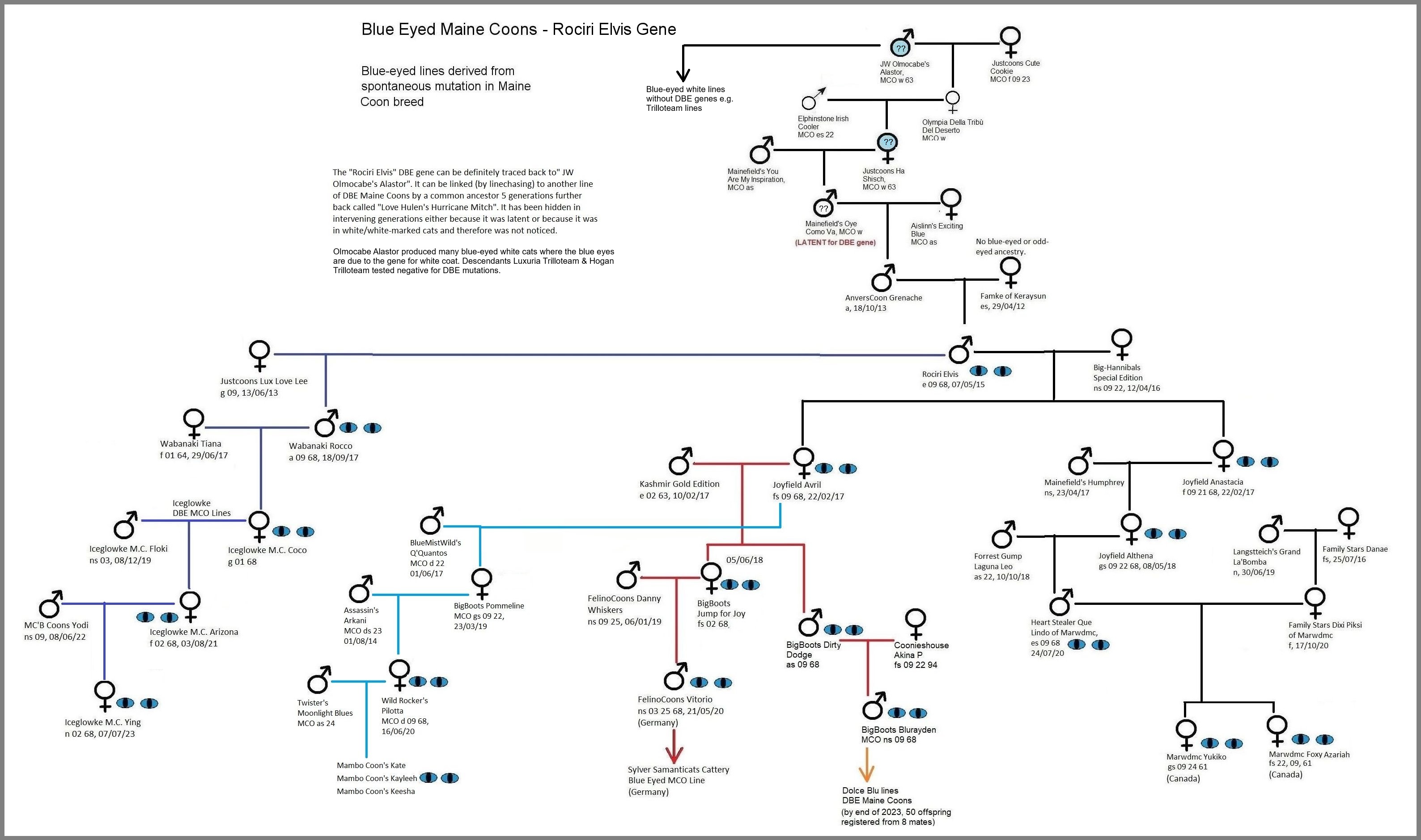
Rociri Elvis Gene (Summary): PAX3 haploinsufficiency in Maine Coon cats with dominant blue eyes and hearing loss resembling the human Waardenburg syndrome
Gabriela Rudd Garces, Daniela Farke, Martin J Schmidt, Anna Letko, Katja Schirl, Marie Abitbol, Tosso Leeb, Leslie A Lyons, Gesine Luhken, G3 Genes|Genomes|Genetics, 2024;, jkae131, PAX3 haploinsufficiency in Maine Coon cats with dominant blue eyes and hearing loss resembling the human Waardenburg syndrome Published: 13 June 2024
Dominant blue eyes (DBE) with minimal white spotting cats, are characterized by pigmentary abnormalities of the iris and skin, and in some cases, sensorineural hearing loss. This is due to abnormal distribution of melanocytes during embryo development, leading to a lack of melanocytes in the eyes and skin. The causative genetic variant has been found in the PAX3 gene, which affects (among other things) the differentiation of melanoblasts into melanocytes. DBE cats are characterised by striking blue eyes (one or both) in combination with variable white patches of fur. "Latent DBE cats" have minimal white spotting and no blue eyes but display a red-eye effect during infancy.
This study suggested that genetic variant known as DBERE ("Rociri Elvis" gene) causes DBE with deafness, but this was not upheld in a later study into DBE-AGO and DBE-RE mutations and a potential conflict of interest was noted in the study into the Rociri Elvis mutation. The phenotype of the heterozygotes resembles human Waardenburg syndrome type 1 and the Splashed white in horses. It seems likely that homozygous DBERE is lethal in the womb. Special examination methods (BAER test) is needed to determine if there is impaired hearing. DNA testing can identify the DBERE variant and auditory testing can determine if deafness is present.
The DBERE test identified the substitution of 1 base pair c.937C>T in the PAX3 gene.
n/n = homozygous normal = Wild type: does not have the PAX3: c.937C>T nonsense variant (DBERE); if the tested cat has the DBE phenotype it is caused by a different genetic variant.
n/ DBERE = heterozygous for the mutation = DBE with potential deafness. One copy of DBERE variant, 50% of offspring will inherit the variant and potential deafness.
DBERE / DBERE = homozygous for the variant gene, not viable (die in utero or at birth).
A Maine Coon breeder had reported multiple deaths in several litters from 2020 to 2023 and observed signs of deafness in blue-eyed cats. These all traced to the Rociri Elvis line (Dutch line). All blue-eye cats showed hearing abnormalities, but normal green-eyed cats did not. 58 cats from two different DBE lineages (48 from the Dutch Rociri Elvis line and 10 from the Topaz lines), were sampled. None of the cats had the dominant white KIT gene mutation, but some had white spotting related to the KIT gene.
The 48 cats from the Rociri Elvis bloodline included 9 green-eyed and 31 blue-eyed cats, some of the later having impaired hearing. There were 8 stillborn kittens, but cause of death was not related to presence of the PAX3 mutation. A single copy of the mutant allele (PAX3: c.937C>T) was found to cause DBE, impaired hearing loss and minimal white spotting. Samples from the Topaz lineage included 10 blue-eyed animals; 8 cats were BAER tested and showed signs of impaired hearing.
All 31 blue-eyed cats from the Dutch lineage were heterozygous for the mutant PAX3:c.937C>T nonsense variant, while all 9 green-eyed cats were homozygous wildtype. The Topaz lines did not have this mutation.
The German Animal Protection Law prohibits the breeding of animals with defective hearing. The Rociri Elvis (DBERE) and Topaz (Seymour line) genes have led to multiple DBE breeding programmes. The researches advocated implementation of PAX3 variant testing for all DBE cats in order to select suitable mating partners, avoid mixing DBE mutations and avoid the mutations strongly linked to impaired hearing.
Note: Following the 2025 study into the Agostino gene, there is a possibility that DBE-RE and DBE-AGO (which had not been identified in 2024) were both present in some cats, leading to deafness and other issues due to the absence of any fully functioning PAX3 gene.

The family trees below show all of Rociri Elvis's registered DBE offspring at the time of this article. Right click the image and open in a new tab to zoom in on the image on your browser. Bear in mind that there may be unidentified latent cats not showing blue eyes, but able to pass on the gene.
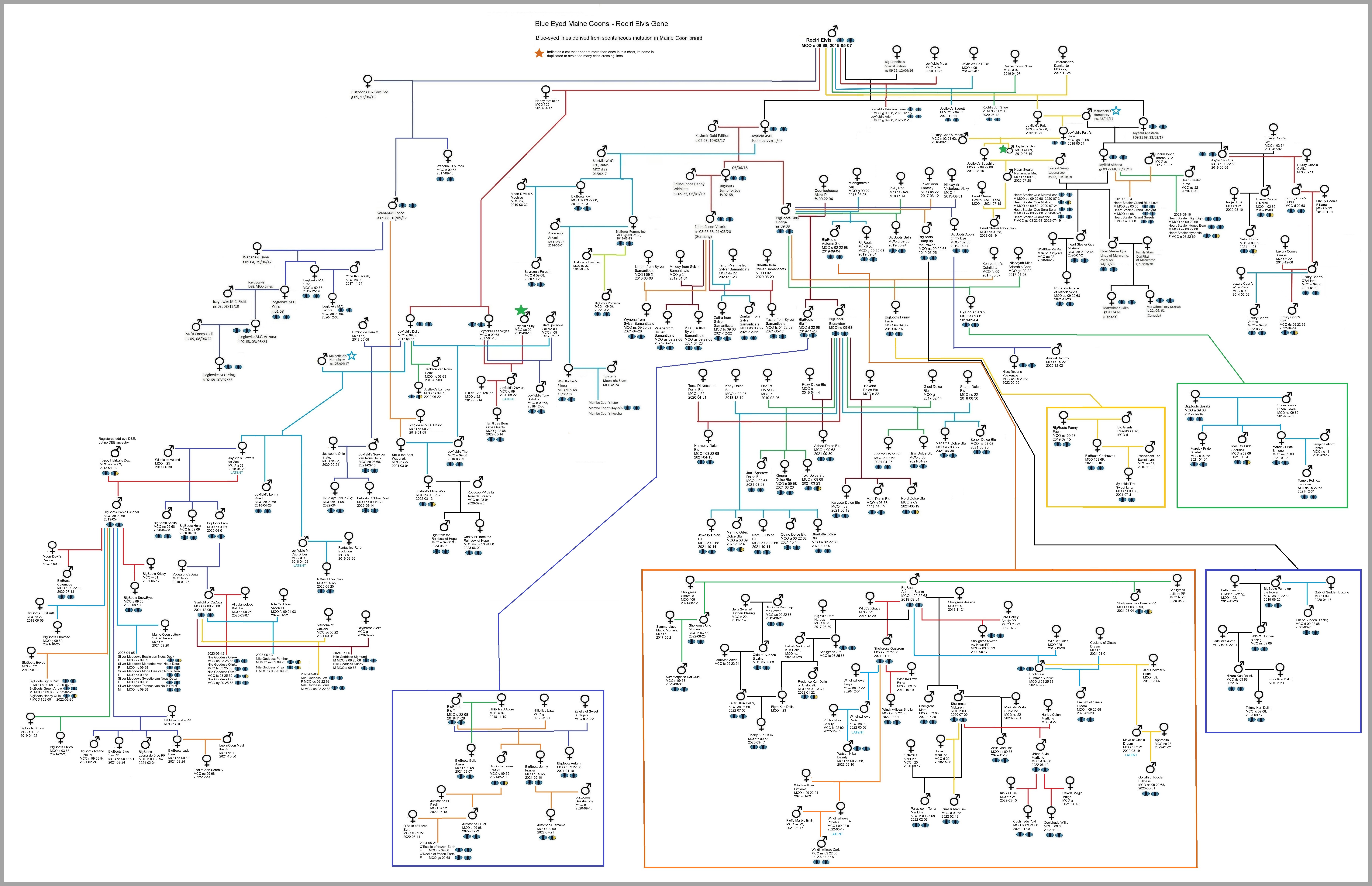

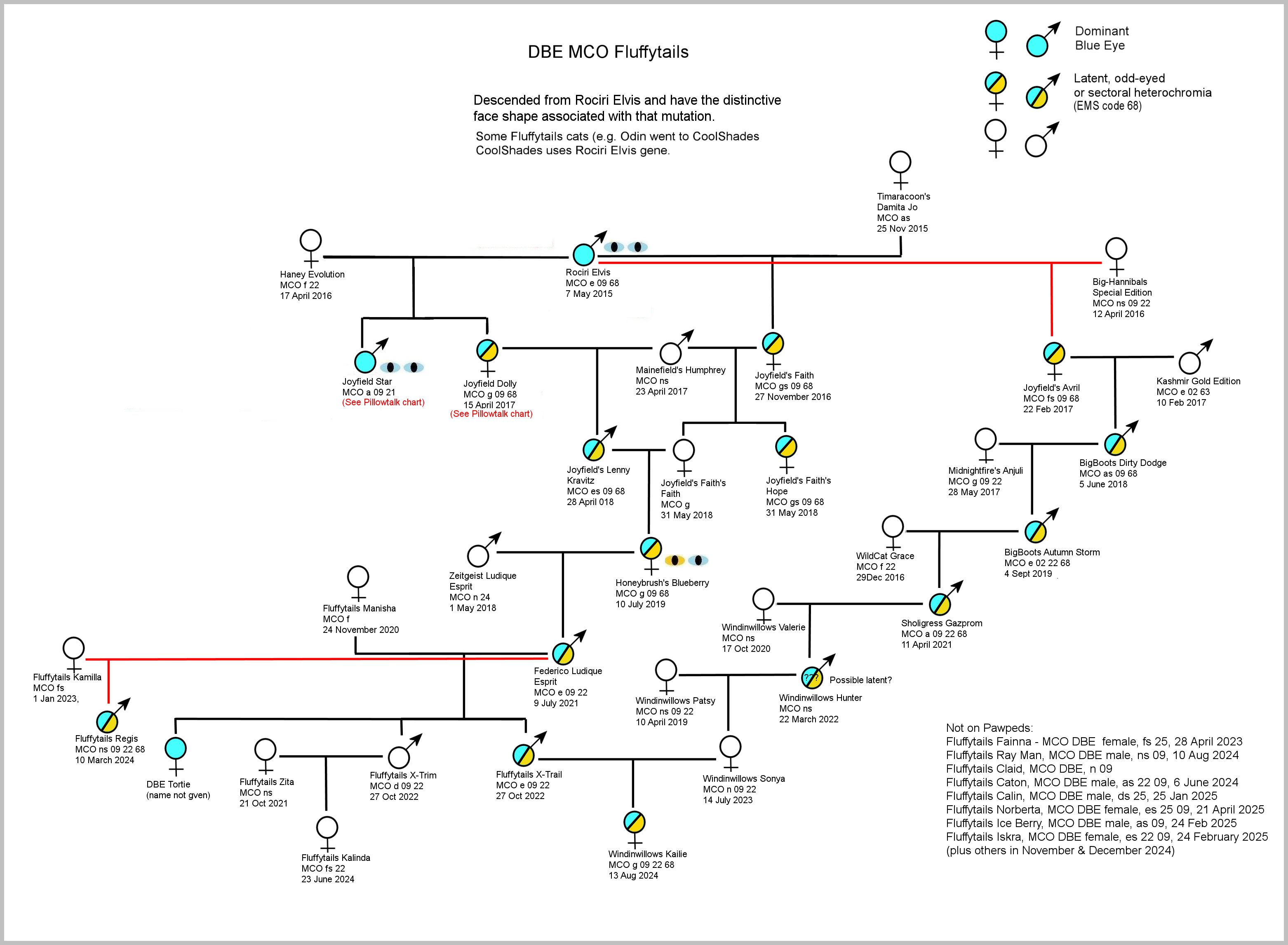
ALTAI MAINE COON (Roxi Darlin DBECEL Gene)
Blue Ridge Cattery's Maine Coons are descended from Topaz Nikita'l Markiss (Nikital Seymour x Nikita'l Pheer-Ca, Pheer-Ca being the daughter of Roxi Darlin x March Nikita'l). One of the blue-eyed cats from this cattery, Blue Ridge Riks, became a foundation cat at Dolce Blu cattery and sired many blue-eyed and odd-eyed offspring. Testing has found the gene to be DBECEL from Roxi, rather than the Seymour (DBEALT) gene. Dolce Blu cattery also has DBE cats descended from Rociri Elvis.
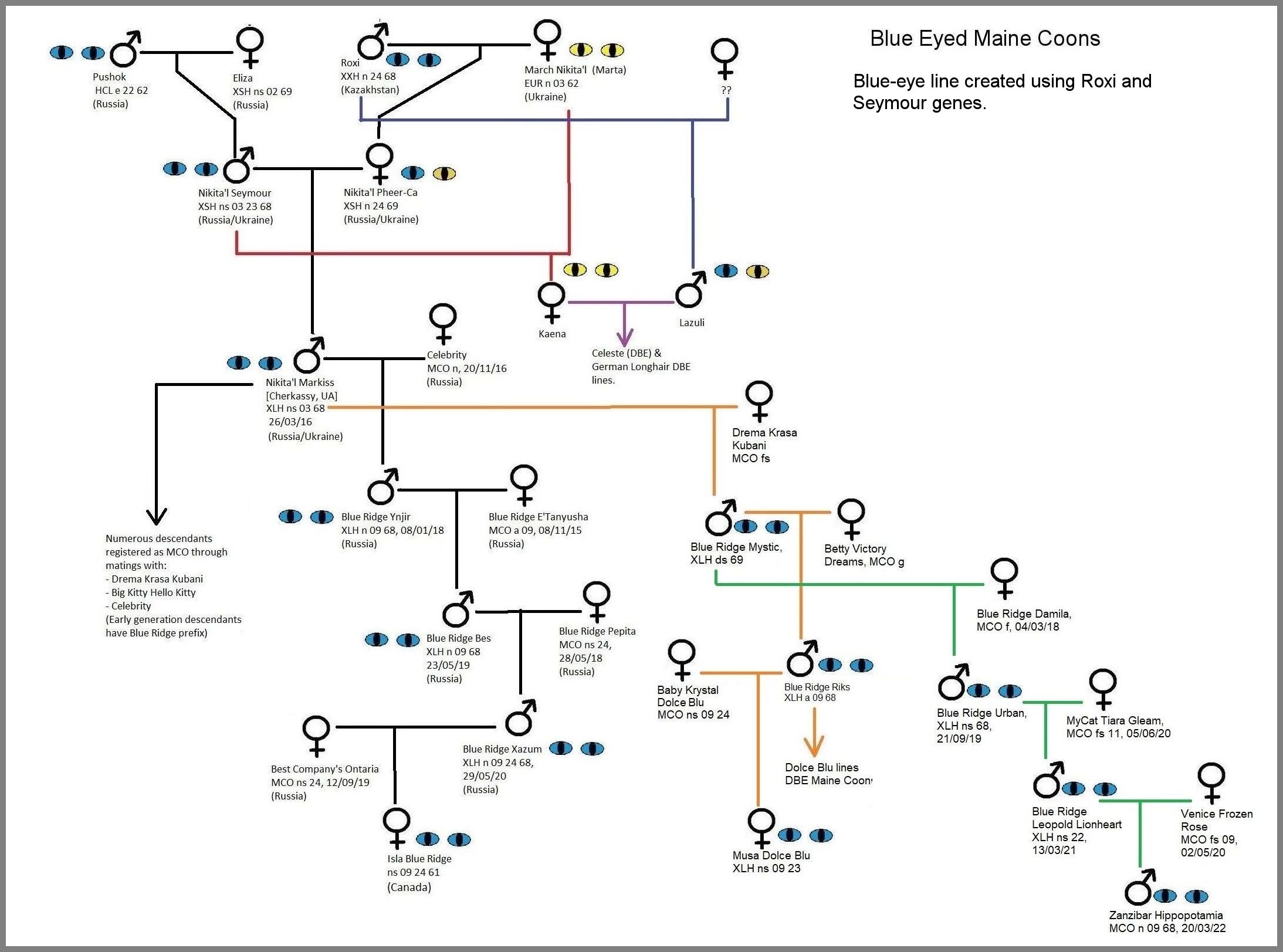
Aleksandra Arakeliants (Blue Ridge Cattery) has been working since 2017 to develop a line of blue eyed Maine Coons using the Roxi and Seymour genes for eye colour. The plan is to keep the lines separate as it is not safe to mix 2 DBE genes (health issues occurred when DBECEL and DBEALT was combined with another gene in the early development of the Topaz breed). The following information is from Sandra Peacock (MARWDMC , Marwood Maine Coons) in December 2023 and Feb 2024. Sandra has been in love with the blue-eyed look since young and when she first saw a blue eyed Maine Coon she decided to carefully research the trait and introduce it into her cattery. In 2020 she acquired Blue Ridge Isla, DBECEL gene from an Altai breed outcrossing. The two lines are kept completely separately. Blue Ridge Isla (DBECEL) is more petite than her average queen but is proportionate with a good head and personality. Crossing to other Maine Coons will improve the size and facial profile. Neither the MARWDMC or Blue Ridge lines have shown any health issues related to eye colour.
BLUE-EYED BREEDS - BLUE-EYED MAINE COON (Agostino Line, DBEAGO)
Lisabeth Hedman Penn in Sweden is working with the Agostino line of DBE Maine Coons (DBEAGO mutation). She has the female Mainly Coozy Atsuko and sent swabs to Marie Abitbol. The mutation didn't match any of the previously identified DBE mutation and the cats don’t have the facial features associated with the Rociri Elvis mutation in Maine Coons. In Sweden, Lisabeth (Lussebullens cattery), Mainly Coozy cattery, and Ivy Osenstam (Ghost of Ivy cattery, who has the DBEAGO male Nanuk Azuro Werra Pearl) are working with this mutation. In Italy, Lord of Kuhn cattery are working with this mutation from the female Agostino Cindy Blue.
Dominant blue eyes in Maine Coon cats: New PAX3 variant and updated phenotypic data
Three PAX3 genes have previously been identified s causing the DBE trait in cats. In June 2025, Marie Abitbol identified a fourth PAX3 variant in purebred Maine Coons. This is now called the Agostino line and the gen is DBEAGO (or DBE-AGO, Agostino Dominant Blue Eyes). The mutation produces a truncated PAX3 protein: PAX3:p.(His54ThrTer108) that would lack 78% of the amino acids of the wildtype protein. No deafness has been reported in DBE-AGO Maine Coons. Initially four distinct lines were identified in the Maine Coon: Rociri Elvis (spontaneous mutation DBE-RE), Topaz (DBE-CEL mutation), Pillowtalk-Foreigner (unknown mutation), and Nahal (unknown mutation) lines. The Agostino mutation is the third identified mutation in the breed.
Note: This study also revisted the data on the Rociri Elvis mutation and found the incidence of deaafness to be over-reported.
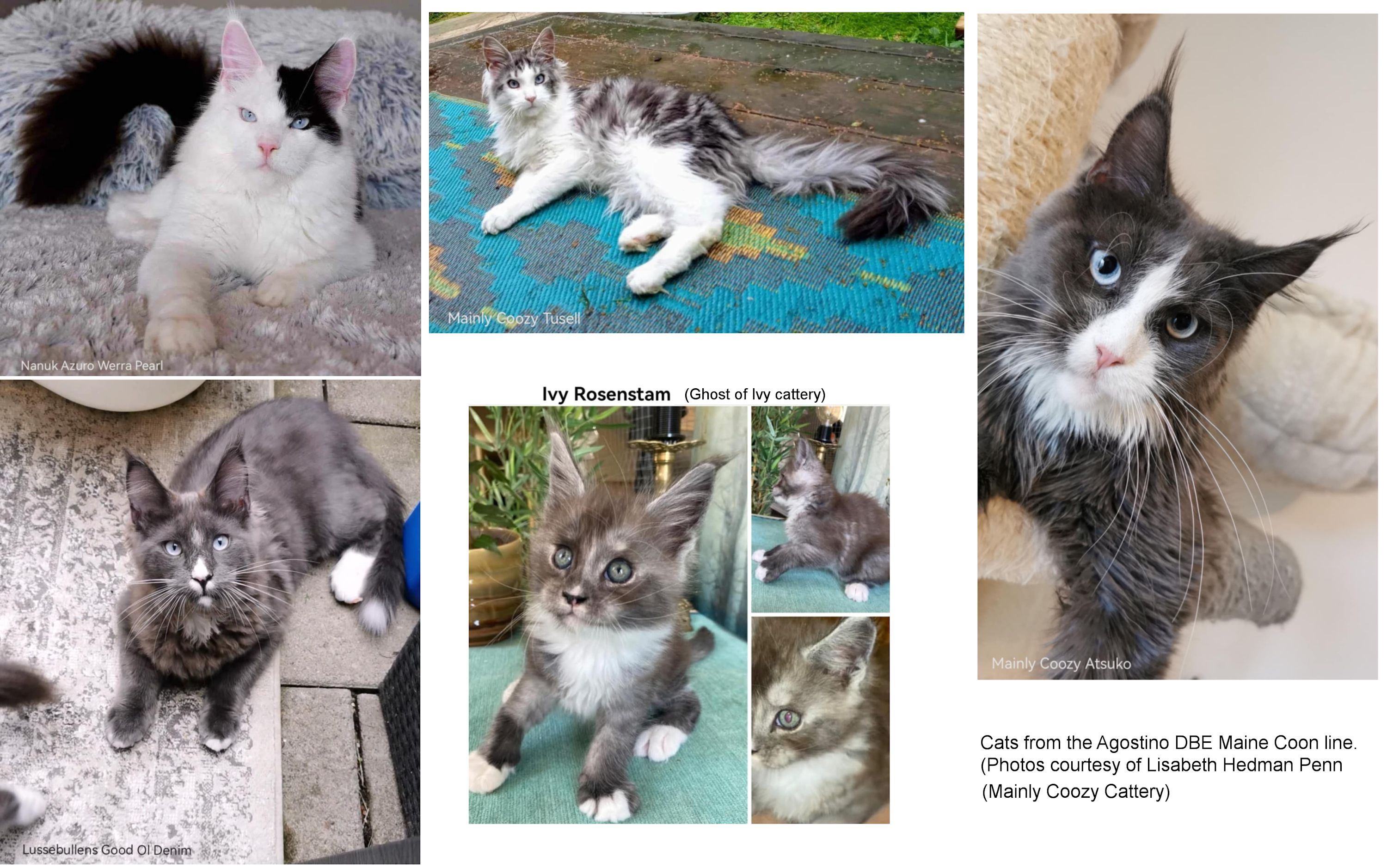
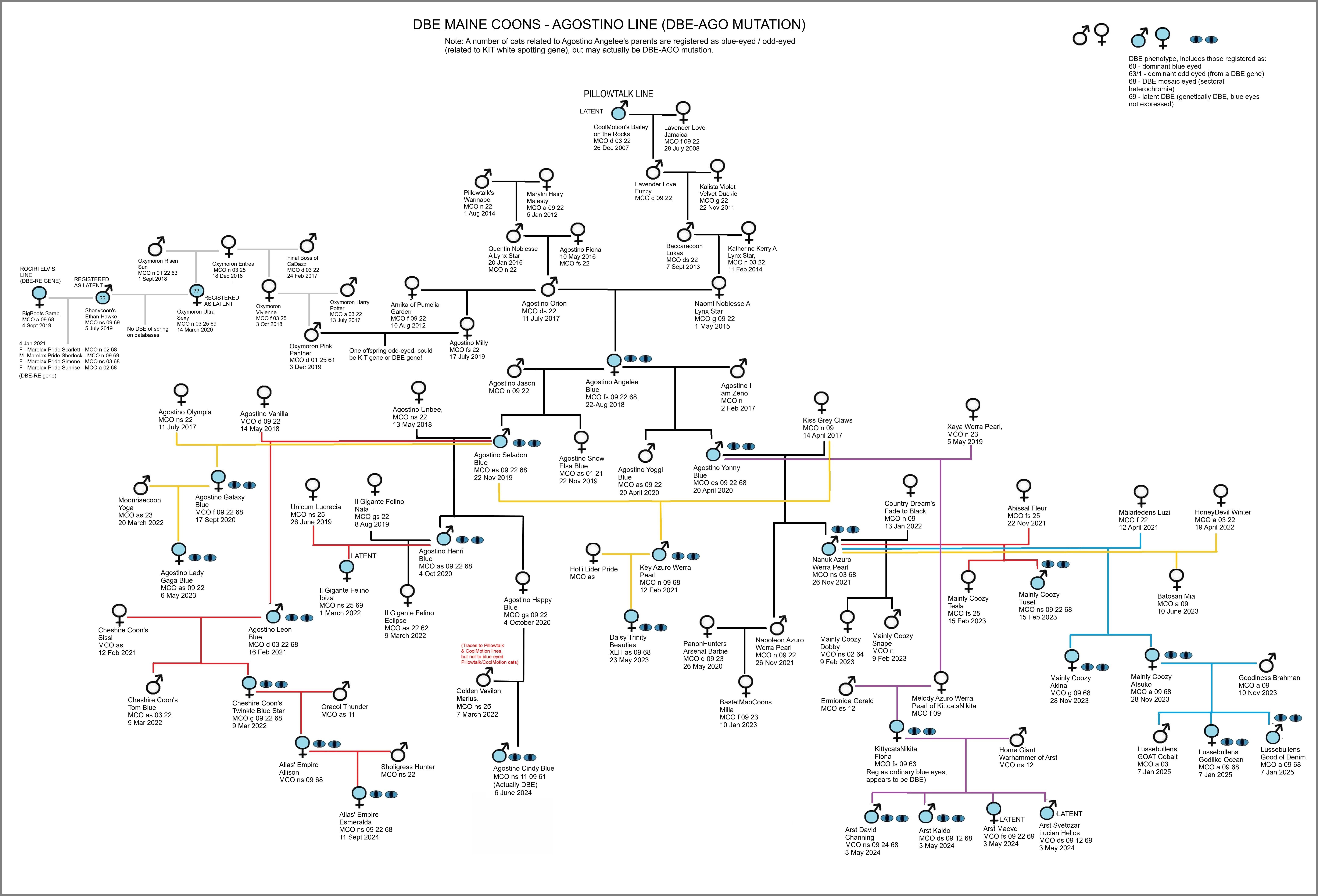
BLUE-EYED BREEDS - BLUE-EYED MAINE COON (Pillowtalk/Foreigner Line)
This DBE gene has been traced back to a common ancestor with Rociri Elvis, but there are no DNA test results (2024). It is a latent gene which means it is often masked by other genes in the genome and only shows visibly when the masking genes are absent.

DBE POLYDACTYL MAINE COONS (KATRIN STYLE CATTERY) (Nahal Gene & Rociri Elvis DBERE Gene)
Katrin Style cattery (Ekaterina Belikova, Taganrog) used a DBE domestic cat named Nahal to introduce blue eyes into polydactyl Maine Coon. The breeder has only worked with DBE heterozygotes and has never tried to breed homozygous kittens. Despite this, some cats, including those who are not blue-eyed (latents?), were deaf. Some of the latents display red eye shine, rather than the normal green eye shine.
Katrin Style cattery has a second line of DBE Maine Coons descended from a cat in the Dolce Blu cattery in Italy. This line descends from the spontaneous mutation seen in Rociri Elvis, born in 2015 in the Netherlands. Elvis's ancestors included normal blue-eyed white and odd-eyed white cats and it is believed that a mutation occurred in the KIT white spotting gene resulting in the DBE trait. Elvis's gene has been used in a number of other Maine Coon lines in Europe and North America (Iceglowke, FelinoCoons, Joyfield and Marwdmc).
OTHER BLUE-EYED MAINE COONS
Another blue-eyed Maine Coon came from Hungary. There are also odd-eyed and recessive blue-eyed Maine Coons. Alfheim Maine Coons have Sinon (DBE tortie & white and Filo (odd-eyed silver tortie tabby) both from Slovakia, and have bred DBE kittens. Zia Maine Coons (New Mexico) also have a Russian DBE Maine Coon: Zia Pacific Pearl (female silver tabby & white, blue eyes). Zia Micah Leo and Pacific Pearl have produced at least one DBE kitten.
A German breeder of DBE Maine Coons (undisclosed mutation) has found that her DBE Maine Coons with full colour can be deaf and this is not uncommon. Other breeders have had deaf full-colour Maine Coons from the same line. The DBE Maine Coon from this line has the wider-spaced eyes or telecanthus when compared to one with normal eye colour. when I look at the photos of the two cats in blue, I have to say that the blue-eyed one looks different. The eye spacing is characteristic of the mutation which means it is unlikely to improve with each generation of breeding. Although the mutation used was not disclosed, this deafness in full-colour DBE cats has been seen in the Aktau blue-eyed mutation (tracing to a cat called Caspian Black Hole). Some Aktau lines were bred to Barnaul mutation lines (founded by Velvet Slavicat). There is also the Rociri Elvis mutation which seems to be a mutation (in the Netherlands) of the "normal" white spotting gene.
MULTIPLE DBE GENES IN MAINE COONS
There are now multiple lines of DBE Maine Coons, some with the Rociri Elvis mutation, others with the Altai and/or Seymour gene (multiple generations of breeding suggest these two do not have adverse consequences when mixed) and an unknown gene from a domestic cat called Nahal. It is not known what will happen when the Seymour, Altai and Rociri Elvis genes are bred together.
